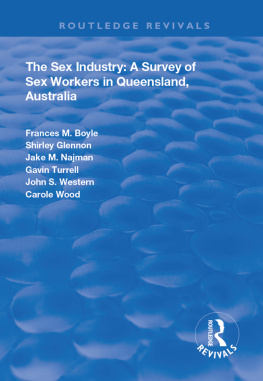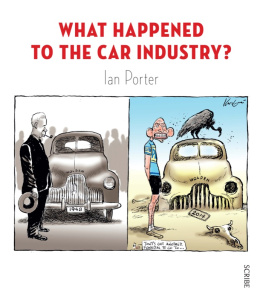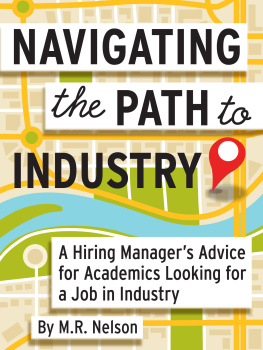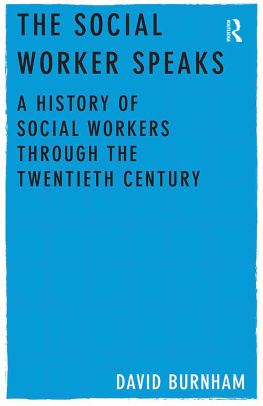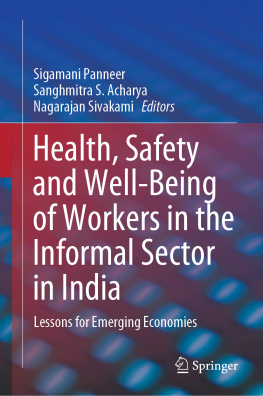THE SEX INDUSTRY: A SURVEY OF SEX WORKERS IN QUEENSLAND, AUSTRALIA
The Sex Industry: A Survey of Sex Workers in Queensland, Australia
FRANCES M. BOYLE
SHIRLEY GLENNON
JAKE M. NAJMAN
GAVIN TURRELL
JOHN S. WESTERN
CAROLE WOOD
First published 1997 by Ashgate Publishing
Reissued 2018 by Routledge
2 Park Square, Milton Park, Abingdon, Oxon, OX14 4RN
711 Third Avenue, New York, NY 10017, USA
Routledge is an imprint of the Taylor & Francis Group, an informa business
Copyright F.M. Boyle, S. Glennon, J.M. Najman, G. Turrell, J.S. Western and C. Wood 1997
All rights reserved. No part of this book may be reprinted or reproduced or utilised in any form or by any electronic, mechanical, or other means, now known or hereafter invented, including photocopying and recording, or in any information storage or retrieval system, without permission in writing from the publishers.
Notice:
Product or corporate names may be trademarks or registered trademarks, and are used only for identification and explanation without intent to infringe.
Publishers Note
The publisher has gone to great lengths to ensure the quality of this reprint but points out that some imperfections in the original copies may be apparent.
Disclaimer
The publisher has made every effort to trace copyright holders and welcomes correspondence from those they have been unable to contact.
A Library of Congress record exists under LC control number: 97070899
ISBN 13: 978-1-138-36006-8 (hbk)
ISBN 13: 978-0-429-43333-7 (ebk)
Contents
The research team acknowledges the many people who supported this study in numerous ways. Special thanks go to all those who participated in the interviews, the Management Committee, staff and members of SQWISI, the advisory committee members, the community organisations QIVAA and QUAC, the HIV/AIDS Section of Queensland Health, and Jill Pappos, Jenny Figueiredo, Zoe Gregoratos, Anna Bartos and Irene Saunderson of the Department of Anthropology and Sociology at The University of Queensland. Thanks also go to Renie Johnston for the many hours spent typing the questionnaire during the various stages of its development.
Particular acknowledgement is due to the studys research assistant who chooses to remain anonymous. She conducted the majority of the interviews and her hard work, patience, care and attention to detail, proved invaluable in ensuring the success of this research project. Thanks are due too to a second research assistant, who also remains anonymous, for conducting some of the interviews.
This monograph presents the findings of a survey of sex industry workers in Queensland, Australia. Conducted between July 1991 and February 1992, the primary aim of the study was to investigate HIV/AIDS prevention in the sex industry. In so doing, the study sought to examine in some detail the social context of sex work, the work and non-work preventive practices of sex workers and their health-related attitudes, beliefs and behaviours.
The presented findings are based on quantitative and qualitative data derived from semi-structured interviews with 230 sex workers from a number of centres throughout Queensland. The main focus is on the 200 female workers who participated in the study, with a separate chapter devoted to the much smaller group of 28 male sex workers. Data collected from two transsexual workers are not included. None of the workers in the study sample were HIV positive according to their own self-reports. This is consistent with data from other studies indicating a low prevalence of HIV infection among Australian sex workers (Donovan, 1990; Feacham, 1995).
The social and political climate in which the study was undertaken produced certain challenges to the recruitment of workers to the study. In the aftermath of the Fitzgerald Inquiry into official corruption involving links with prostitution in Queensland, the sex industry was operating in a low key and underground manner. Strategies to enhance the participation of a large and representative sample of workers included the involvement of members of the sex workers collective, Self-Health for Queensland Workers in the Sex Industry (SQWISI), the establishment of an Advisory Committee that included sex industry workers and the appointment of a research assistant and interviewer who had first hand experience in the sex industry. The diversity of work settings and the varied sociodemographic characteristics of the group of sex workers who participated in the study, we believe, reflects the success of these strategies.
Frequently, discussions about the sex industry and its workers start from the perspective of prostitution as a problem. The problem, however, is often not articulated clearly and a variety of assumptions are made about the nature of the sex industry and the causes and consequences of prostitution. This study attempted to take a different starting point by avoiding, as far as possible, assumptions and judgements about prostitution. It took instead an exploratory approach which enabled the collection of information about and, we hope, some insights into the health and the protection and promotion of health among members of what is certainly a very diverse and complex social milieu.
While there are significant gaps in the study of prostitution, there has been a renewal of interest in the last decade. In Australia, three sex work conferences have taken place since 1988 in Melbourne, Brisbane and Canberra. These have arisen largely in response to pressures associated with both a growing movement among sex workers, feminists and others concerned with prostitution reform and reviews of prostitution laws in a number of Australian states. They have also attempted to respond to concerns (which, in the face of available data, would seem to be based far more on speculation than on fact) that sex work may be a significant vector of transmission of HIV/AIDS. More recently, Perkins, Prestage, Sharp and Lovejoy (1994) edited a multidisciplinary reader that explores and documents many of the social, legal and health contexts of the sex industry in Australia.
Plan of the book
We begin in the first chapter by examining some of the social, cultural and legal contexts that, both in the past and more recently, have helped to shape the way prostitution is thought about and managed. Considerable reference is made to proceedings from the abovementioned conferences and to the reports of the committees of inquiry held in various Australian states. Because of its obvious relevance to the socio-legal context of the present study, the chapter draws heavily on the Criminal Justice Commission Report (CJC, 1991), Regulating Morality? An Inquiry into Prostitution in Queensland. We then move on to the details of our study of sex workers in Queensland. In examines the kinds of settings in which women were working and also considers how and why they entered the sex industry. We see that the promise of financial returns is clearly of central importance to the womens decisions to enter and remain in the sex industry.
In highlights an issue that is often overlooked by some discussions, namely the fact that threats to sex worker health frequently extend well beyond the arena of paid sexual encounters. Partners in the workers private lives and the workers own use of drugs (both legal and illegal) pose a potential threat to the health of many sex workers.

